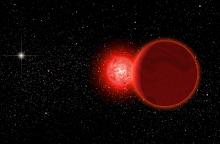Listen to today's episode of StarDate on the web the same day it airs in high-quality streaming audio without any extra ads or announcements. Choose a $8 one-month pass, or listen every day for a year for just $30.
You are here
Camelopardalis
The constellation named for the giraffe is tall, as you might expect. But it isn’t bright. None of its stars is brighter than fourth magnitude. That means you need dark skies to see them — away from the glare of city lights.
Camelopardalis wraps around Polaris, the north star. Its main outline is in the north-northeast at nightfall. It stands high above Polaris around midnight, and whirls to the north-northwest at first light.
The constellation was created by Petrus Plancius, a Dutch astronomer and priest. He drew it on a celestial globe in the early 17th century. He linked up some stars in a dark region of the sky, where no one had bothered to create a constellation before.
The fact that we see some of the giraffe’s brighter stars at all is a testament to the stars themselves. The brightest star, Beta Camelopardalis, is more than 850 light-years away. The star is a yellow supergiant. It’s about the same temperature as the Sun, but much bigger and heavier, and thousands of times brighter.
The third-brightest star, known as Alpha, is even more impressive. It’s a blue supergiant. It’s not only bigger and brighter than the Sun, it’s thousands of degrees hotter as well. And it’s visible from a distance of 6,000light-years — one of the most-distant stars that’s visible to the unaided eye.
So if you have a clear, dark sky, look toward the north for Camelopardalis — a big, faint constellation with some impressive stars.
Script by Damond Benningfield






